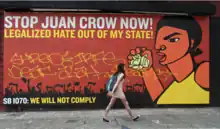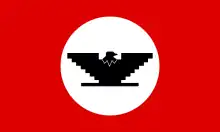Juan Crow
Juan Crow is political terminology that was coined by journalist Roberto Lovato.[1][2][3][4][5][6] It first gained popularity when he used it in an article for The Nation magazine in 2008.[7] "Call it Juan Crow: the matrix of laws, social customs, economic institutions and symbolic systems enabling the physical and psychic isolation needed to control and exploit undocumented immigrants." Lovato utilized the term to criticize immigration enforcement laws by analogizing them to Jim Crow laws, and has since become popular among immigration activists.

| Part of a series on |
| Chicanos and Mexican Americans |
|---|
 |
|
In recent years, the term Juan Crow has also been used to discuss the historical discrimination against Mexican Americans in the U.S. as analogous to the treatment of African Americans in the Jim Crow era, specifically as related to mob violence and segregation in schools.[8][9][10][11]
Immigration Enforcement
The term Juan Crow was first used to refer to immigration enforcement statutes in the United States that penalize illegal immigration and deny services to undocumented people living in the U.S. unlawfully.[12][13][14]
Laws in Arizona,[15] Alabama,[12] Georgia,[7] and Texas[16][17] have been considered Juan Crow laws.
California's Proposition 187 was considered a Juan Crow law by immigration activists. It required citizenship screening of residents and denied social services like health care and public education to undocumented immigrants.[18]
Mob Violence
The term Juan Crow has also been used to refer to historical instances of mob violence, as well as de facto discrimination that specifically targeted Mexicans and people of Mexican descent.[8][19][20][21] Between the years 1848 and 1928, mob violence against people of Mexican descent totaled 547 lynchings.[22] Texas holds the highest tally with 232 victims.[22] Other Southwest states, which include California, Arizona, and New Mexico, range between 25 and 143 lynching murders.[22][23]
In the 1850s, after the Mexican-American war, Anglo-Americans were concerned about the potentiality of Mexican-Americans responding to Mexican newspapers that called for the Reconquista (reconquering).[8] Consequently, Anglo-Americans advocated for the systemic inequity of Mexican-Americans through social exclusion and lynchings.[8] The mistreatment persisted for several decades, with the Texas Rangers acting as enforcers and overseeing 232 Mexican-American men to violent attacks by mob violence between 1848 and 1928.[8][24]
Mexican-Americans were often victims of lynching by Anglo-American society, but there were also occurrences of Mexicans lynching Mexicans.[22][23] In particular, Mexican-Americans of higher class status who were aligned with Anglo ranchers participated in such acts.[22][23] The culture's acceptance of lynching impacted Mexican standards during the 19th and 20th centuries.[22][23] Mexican Americans were not only hung, but mob violence included other forms of brutality such as shooting, burning people alive, physical mutilation, and other deadly acts of persecution.[22][23][25]
During the 1870s and 1880s, the use of the derogatory term “greaser” promoted the Texas Rangers to carry out a campaign against the Mexican populace of the Rio Grande Valley.[8] They believed that by instilling fear, they could more effectively suppress the Mexican population.[8]
In 1918, a group of Anglo ranchers and the Texas Rangers arrived at a village in Presidio County, Porvenir, where 140 refugees, including women, children, and men, resided.[25][8][24] Despite no evidence of weapons or stolen goods, thirteen Mexican men and two teenage boys were killed on suspicion of banditry.[25][8][24] The Porvenir massacre, as described by historian Miguel A. Levario, exposed the violence committed by the Rangers against Mexicans.[8]
With a dual identity, the Texas Rangers are an emblem of Texan pride from an Anglo perspective.[24] They enhanced the quality of life for colonists by actively confronting and defeating Indigenous peoples, outlaws, and Mexicans.[24] However, for their Mexican victims, they are a source of terror and oppression.[24]
Juan Crow in Education
The segregation of Mexican American students in academia is a disputed topic with various perspectives.[26] Mexicans, who were then considered to be white, were never legally segregated and normally went to white schools, but some children were placed in special education within the white school system due to language. It is being asserted as racial segregation by some historians today. The state did not officially sanction their discrimination.[26][27] Some scholars argue it was de facto segregation from the local customs that intentionally separated Mexican American students.[26] In contrast, others express it was de jure segregation as school officials enforced their policies.[26] Although legally classified as "White," some historians argue that Mexican Americans were socially perceived as "colored" and subject to segregation in schools and communities.[26][27] Despite the lack of state-sanctioned segregation laws, it was a prevalent trend in the American Southwest.[26][27]
See also
References
- Mendoza, José Jorge (2015). "Doing Away with Juan Crow: Two Standards for Just Immigration Reform". APA Newsletter on Hispanic/Latino Issues in Philosophy. 15 (2): 14–20.
- Davila, Arlene (2012). "To stop tip-toeing around race: what Arizona's battle against ethnic studies can teach academics". Identities. 19 (4): 411–417. doi:10.1080/1070289X.2012.699878. S2CID 144194993. Archived from the original on 2022-06-12. Retrieved 2022-06-12.
- Embrick, David G. (2020). "Capitalism, Racism, and Trumpism: Whitelash and the Politics of Oppression". Fast Capitalism. 17 (1): 203–224. doi:10.32855/fcapital.202001.012. ISSN 1930-014X. S2CID 225674153. Archived from the original on 2022-06-18. Retrieved 2022-06-12.
- Cullison, Jennifer L. (2018). The Growth of Immigrant Caging in Postwar America: National Immigration Policy Choices, Regional Shifts Toward Greater Carceral Control, and Continuing Legal Resistance in the US and South Texas (Phd). University of Colorado at Boulder. Archived from the original on 2022-08-20. Retrieved 2022-08-20.
- Silva, Grant J. (2015). "Why the Struggle Against Coloniality is Paramount to Latin American Philosophy". APA Newsletter on Hispanic/Latino Issues in Philosophy. 15 (1).
- Marquez, Cecilia (2019). "Juan Crow and the Erasure of Blackness in the Latina/o South". Labor. 16 (3): 79–85. doi:10.1215/15476715-7569839. S2CID 204424763. Archived from the original on 2022-08-20. Retrieved 2022-08-20.
- Lovato, Roberto (26 May 2008). "Juan Crow in Georgia". The Nation. Archived from the original on 25 October 2020. Retrieved 18 June 2012.
- Krochmal, Max; Moye, J. Todd (2021). "Chapter 12: Self-determined Educational Spaces: Forging Race & Gender Power in Houston". Civil RIghts in Black and Brown: Histories of Resistance and Struggle in Texas. Austin, Texas: University of Texas Press. pp. 246–247.
- Madrigal-Garcia, Yanira I.; Acevedo-Gil., Nancy (2016). "The New Juan Crow in Education: Revealing Panoptic Measures and Inequitable Resources That Hinder Latina/o Postsecondary Pathways". Journal of Hispanic Higher Education. 15 (2): 154–181. doi:10.1177/1538192716629192. S2CID 119075376 – via Sage Journals.
- Isom Scott, Deena (2020). "The New Juan Crow? Unpacking the Links Between Discrimination and Crime for Latinxs". Race and Justice. 10 (1): 20–42. doi:10.1177/2153368717721613. S2CID 219919761 – via Sage Journals.
- Martinez, Marlene (2019). "Juan Crow". The Measure: An Undergraduate Research Journal. 3: 87–97.
- Person, David (November 1, 2011). "'Juan Crow' law alive and well in Alabama". USA Today.
- Cohen, J. Richard (14 June 2008). "Meet "Juan Crow"". Huffington Post. Archived from the original on 3 August 2009. Retrieved 18 June 2012.
- Millan, Claudia (2013). Latining America: Black-Brown Passages and the Coloring of Latino/a Studies (PDF). Athens, Georgia & London: The University of Georgia Press. p. 191. Archived (PDF) from the original on 30 November 2021. Retrieved 7 October 2020.
- Traywick, Catherine. "Juan Crow Laws in Arizona". Campus Progress. Center for American Progress. Archived from the original on 4 January 2011. Retrieved 18 June 2012.
- Gamboa, Suzanne (June 3, 2017). "History of Racism Against Mexican-Americans Clouds Texas Immigration Law". NBC News. Archived from the original on 21 October 2020. Retrieved 7 October 2020.
- Torres, Gerald (June 2006). Law and Class in America - Trends Since the Cold War: The Elusive Goal of Equal Educational Opportunity. New York and London: New York University Press. p. 331. ISBN 978-0814716540. Archived from the original on 5 April 2023. Retrieved 7 October 2020.
- Arellano, Gustavo (2014-09-18). "Republicans used California's 'Juan Crow' law as a model for other states. Now it's dead, and so is the far-right". The Guardian. Guardian News and Media Limited. Archived from the original on 2016-03-23. Retrieved 2016-03-16.
- Zapata, Joel (2021). "Chapter 5: The South-by-Southwest Borderlands' Chicana/o Uprising: The Brown Berets, Black and Brown Alliances, and the Fight against Police Brutality in West Texas". In Moye, J. Todd; Krochmal, Max (eds.). Civil Rights in Black and Brown: Histories of Resistance and Struggle in Texas. Austin, Texas: University of Texas Press. p. 93.
- Wall, James B. (2021). "Chapter 6: The Long Shadow of Hector P. Garcia in Corpus Christi". In Krochmal, Max; Moye, J. Todd (eds.). Civil Rights in Black and Brown: Histories of Resistance and Struggle in Texas. Austin, Texas: University of Texas Press. pp. 116–120.
- Moye, J. Todd (2021). "Chapter 10: Contesting White Supremacy in Tarrant County". In Krochmal, Max; Moye, J. Todd (eds.). Civil Rights in Black and Brown: Histories of Resistance and Struggle in Texas. Austin, Texas: University of Texas Press. p. 93.
- Carrigan, William D; Webb, Clive (2013). Forgotten Dead : Mob Violence Against Mexicans in the United States, 1848-1928. Oxford University Press. p. 6.
- Mirandé, Alfredo (2020). Gringo Injustice : Insider Perspectives on Police, Gangs, and Law. New York: Taylor & Francis Group. p. 26.
- Harris III, Charles H.; Sadler, Louis R. (2004). The Texas Rangers & the Mexican Revolution: The Bloodiest Decade, 1910-1920. University of New Mexico Press. pp. 2–3, 352–354, 392, 450.
- Urbina, Martin Guevara; Espinoza Álvarez, Sofia (2017). Ethnicity and Criminal Justice in the Era of Mass Incarceration : a Critical Reader on the Latino Experience. Springfield, Illinois: Charles C. Thomas Publisher, Ltd. pp. 50–53.
- Donato, Rubén; Hanson, Jarrod (2012). "Legally white, socially "Mexican": The politics of de jure and de facto school segregation in the American Southwest.". Vol. 82. Harvard Educational Review. pp. 202–203.
- Godfrey, Phoebe C. (2008). The 'Other White': Mexican Americans and the Impotency of Whiteness in the Segregation and Desegregation of Texan Public Schools. Vol. 41. Equity & Excellence in Education. pp. 247–261.